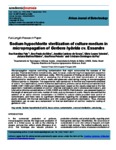Please use this identifier to cite or link to this item:
http://www.alice.cnptia.embrapa.br/alice/handle/doc/1053027| Title: | Sodium hypochlorite sterilization of culture medium in micropropagation of Gerbera hybrida cv. Essandre. |
| Authors: | PAIS, A. K.  SILVA, A. P. da   SOUZA, J. C. de   TEIXEIRA, S. L.   RIBEIRO, J. M.   PEIXOTO, A. R.   PAZ, C. D. da   |
| Affiliation: | ANA KAROLINA PAIS, Departamento de Tecnologia e Ciências Sociais, Universidade do Estado da Bahia – UNEB; ANA PAULA DA SILVA, Departamento de Tecnologia e Ciências Sociais, Universidade do Estado da Bahia – UNEB; JOSELITA CARDOSO DE SOUZA, Departamento de Tecnologia e Ciências Sociais, Universidade do Estado da Bahia – UNEB; SILVIO LOPES TEIXEIRA; JULIANA MARTINS RIBEIRO, CPATSA; ANA ROSA PEIXOTO, Departamento de Tecnologia e Ciências Sociais, Universidade do Estado da Bahia – UNEB; CRISTIANE DOMINGOS DA PAZ, Departamento de Tecnologia e Ciências Sociais, Universidade do Estado da Bahia – UNEB. |
| Date Issued: | 2016 |
| Citation: | African Journal of Biotechnology, v. 15, n. 36, p. 1995-1998, sept. 2016 |
| Description: | Micropropagation requires controlling contamination that might compromise the success of the process. Thermal sterilization is traditionally used; however, costs deriving from equipment acquisition and maintenance render this technique costly. With the purpose of finding an alternative to thermal sterilization, this research aimed at assessing the efficiency and ideal concentration of sodium hypochlorite for sterilization of culture media and glassware used during rooting of micropropagated Gerbera hybrida cv. Essandre. Two experiments were carried out. In the first one, treatments consisted of control I (no sterilization), control II (thermal sterilization), and total active chlorine concentrations of 0.0005, 0.001, 0.002 and 0.003%. In the second experiment, based on the results observed in the first experiment, treatments consisted of control I (thermal sterilization) and II (chemical sterilization), and total active chlorine concentrations of 0.002, 0.0025 and 0.003%. Plant behavior was assessed based on the length of aerial part and roots, number of roots, and dry biomass of plants. Results showed that the addition of an active chlorine concentration of 0.003% to culture media provided total control of contaminants, and there were no significant differences regarding the variables analyzed between plants obtained with thermal sterilization and with sodium hypochlorite sterilization. Thus, chemical sterilization can be used as a replacement for thermal sterilization of nutrition media for rooting of gerbera in vitro. |
| Thesagro: | Cultura de tecido Gerbera Planta ornamental Micropropagação Contaminação |
| NAL Thesaurus: | Sodium hypochlorite Tissue culture |
| Keywords: | NaOC Hipoclorito de sódio Esterilização química Autoclavagem In vitro Chemical sterilization Contamination |
| ISSN: | 1684-5315 |
| DOI: | 10.5897/AJB2016.15405 |
| Type of Material: | Artigo de periódico |
| Access: | openAccess |
| Appears in Collections: | Artigo em periódico indexado (CPATSA)  |
Files in This Item:
| File | Description | Size | Format | |
|---|---|---|---|---|
| Juliana2016.pdf | 330,7 kB | Adobe PDF |  View/Open |









